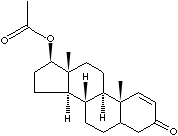PRODUCT IDENTIFICATION

H.S. CODE
TOXICITY
CLASSIFICATION
PHYSICAL AND CHEMICAL PROPERTIES
AUTOIGNITION
NFPA RATINGS
REFRACTIVE INDEX
Stable under ordinary conditions
APPLICATIONS
· Cloxotestosterone (CAS
RN: 53608-96-1)
· Ethisterone
(Ethynyl testosterone, CAS RN: 434-03-7)
· Mestanolone
(CAS RN: 521-11-9)
· 17alpha-Methyltestosterone (CAS RN: 58-18-4)
· Norethindrone
(CAS RN: 68-22-4)
· Normethisterone (CAS RN: 514-61-4)
· Oxymetholone
(CAS RN: 434-07-1)
· Silandrone (Testosterone trimethylsilyl ether,
CAS RN: 5055-42-5)
· Testosterone Acetate (CAS RN: 1045-69-8)
· Testosterone Phenylpropionate
(CAS RN: 1255-49-8)
· Testosterone Benzoate (CAS RN: 2088-71-3)
· Testosterone heptanoate
(CAS RN: 315-37-7)
· Testosterone phenylacetate (CAS RN: 5704-03-0)
· Testosterone propionate
(CAS RN: 57-85-2)
· Testosterone cypionate (CAS RN: 58-20-8)
· Testosterone ketolaurate
(CAS RN: 5874-98-6)
· Testosterone Undecanoate
· Testosterone
Glucuronide
· Testosterone Hemisuccinate
APPEARANCE
ASSAY
MELTING POINT
139 - 141 C
OPTICAL ROTATION
+86° ~ +90°
LOSS ON DRYING
0.5% max
5kgs in can